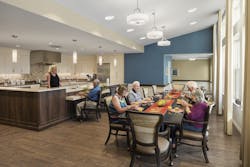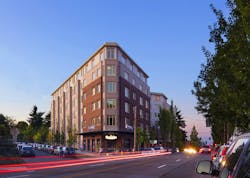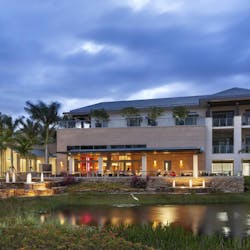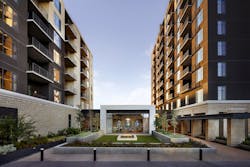Senior living: 4 themes, 9 trends
The terrible toll the COVID-19 pandemic took on frail seniors has accelerated the search for new models that provide safe and desirable housing options for this rapidly growing demographic. The over-65 population is projected to grow from 46 million today, to 71 million by 2030, 33 million of whom will be over 75 with increasing risk of dementia and chronic conditions.
Only about 6% of those over age 65 live in senior living communities, which includes independent living, assisted living, memory care, and skilled nursing, either standalone or part of a life plan community that offers the full continuum of care; the rest live at home. Due to the pandemic, these communities are being guided increasingly by themes of resilience, flexibility and choice, incorporation of new and unconventional models, and the need to expand market share.
RESILIENCE PLANNING: STAYING IN IT FOR THE LONG RUN
1 Addressing future pandemic emergencies. COVID-19, which hit congregate living residents, especially those in skilled nursing facilities, particularly hard, will not be the last deadly pandemic. This certainty is accelerating the move toward a more residential, small-scale type of skilled nursing, the small house model, which groups skilled nursing residents into households of 7-12 persons. Each household looks and functions like a typical home, with a living room, dining room, kitchen, and single-bed resident rooms. This model gives residents more control over their daily lives.
The Green House Project is a nonprofit that developed a proprietary form of the small house model. Recent research into this model showed that COVID transmission and death rates were significantly lower than in traditional skilled nursing environments. Green House residents and staff also reported higher satisfaction levels due to the relationships they are able to cultivate in this small-scale setting.
The Veterans Administration has also adopted this model for all of its long-term-care communities. Perkins Eastman completed such a project for the VA in North Little Rock, Ark. (Polk Stanley Wilcox was the AOR.) It consists of eight 10,000-sf “Community Living Centers,” each with 12 bedrooms and adjoining private baths, plus a common living room, study, dining room, kitchen, and den. Services include skilled nursing care, dementia care, and rehabilitation services.
In October, the firm broke ground on VA small house projects in Bemidji, Preston, and Montevideo, Minn. Perkins Eastman has another VA small house in design in Quincy, Ill.
Owner/developers are also incorporating new technologies, such as telehealth and touchless controls, and redefining the design of dining and amenity spaces to address health emergencies. Perkins Eastman’s July 2020 “COVID-19 Design Tool Kit,” a step-by-step guide to health emergency planning, offers examples of how to avoid congestion points near entrances and food service and guidance for accompanying signage.
2 Responding vigorously to climate change. Growing public awareness of the dangers of climate change has spurred interest in sustainable design strategies such as Passive House, LEED, the WELL Building Standard, and RELi. For optimal effect, resiliency planning that defines design goals and solutions for new construction and existing buildings should be incorporated in capital budgets and implemented at the outset of these projects.
Three examples from our senior living portfolio offer pragmatic ways to incorporate resiliency planning and address climate change.
• The Summit at Rockwood, a 65-unit LEED Silver retirement community in Spokane, Wash., incorporates biophilic design principles, from material health and indoor air quality to connections to nature and natural daylight.
• PHIUS-certified 42 Broad Street is a 16-story residential tower designed around healthy design principles and energy efficiency through passive design. The 249-unit complex’s location at the center of a transit-oriented community in Mt. Vernon, N.Y., fosters interpersonal connection and multigenerational living.
• Woodside Place of Washington, a Presbyterian SeniorCare Network Community in Washington, Pa., 30 miles south of Pittsburgh, is one of the first senior living residences in the world to achieve WELL certification. Through a pilot program with the International WELL Building Institute, this 36-unit senior living community achieved WELL Silver certification specifically adapted to fit the distinctive design needs of an assisted living/memory-care occupancy.
FLEXIBLE SOLUTIONS FOR CHANGING ABILITIES
3 Opening up new housing options. Although some life plan communities, which provide all levels of care, are still being constructed, their size and complexity make them difficult to get off the boards. In response, some developers are offering models targeted at both independent adults as well as seniors who need more support. Older adults can age in place in purpose-built apartments that include supportive elements which enable services to be brought in as needed.
4 Expanding the ability to age in place. As we’ve said, most older adults who live in apartments, cooperatives, or condominiums want to keep living in their current residences. To enable this, more attention is being placed on making new and existing multifamily housing adaptable to their needs—particularly for those suffering cognitive decline. This impacts many aspects of interior design and detailing.
Anthology of King of Prussia, located on 122 acres in the Village of Valley Forge, about 20 miles northwest of Philadelphia, provides 100 independent living, 60 personal care, and 32 memory support residences that are designed for aging in place and operational efficiency. The new memory support residences provide residents with a safe, secure environment that addresses each individual’s capabilities.
UNCONVENTIONAL MODELS FOR GREATER DIVERSITY
5 Exploring new sites for senior living. The collapse of suburban shopping malls and town centers has opened up attractive new site options for senior living development. Perkins Eastman is working with Akara Partners, a multifamily and student housing developer, in the creation of ACTIV, an active-adult apartment complex on the site of a former outlot restaurant and parking lot at the Southwest Plaza Mall in Littleton, Colo. Residents will be able to use a discount card at restaurants and theaters inside the mall. Amenities typically found within the bounds of such a community, such as a sports clinic or a hair salon, will be shifted to the perimeter so that they can be available to the public at large.
New site options are also opening up near colleges and universities. Perkins Eastman is working on senior living developments adjacent to Princeton University, Princeton, N.J., and Lasell University, in the Boston suburb of Newton, Mass. These institutions have recognized the value of attracting older, active adults to live near their campuses, and are incorporating this model into their long-term planning.
6 More infill, less dispersion. Most older adults either want to stay engaged in their communities or become part of new energizing communities where they can embrace an active lifestyle; they’re not necessarily looking for age-restricted communities in quiet rural settings. This makes urban sites near public transit and amenities increasingly desirable for senior living development.
In the words of coauthor Wolf Saar, “We should approach our projects with the philosophy of designing beyond the walls of the residential unit to live the building—incorporating the latest amenities—and to live the city—leveraging the varied venues that an urban lifestyle has to offer.”
One such case is Aegis on Madison Assisted Living + Memory Care, a 120-unit care community in Seattle’s Capitol Hill neighborhood. It has a lively first floor that bridges the pedestrian focus of busy Madison Street and a quieter residential neighborhood to the north.
7 Recognizing the diversity of senior living. The senior living market is not homogeneous. Residents come from a wide variety of backgrounds and have a multitude of interests and abilities. Many programmatic and design solutions that missed this point have failed. Taking their place are cultural, income, generational, and lifestyle options driven by new models, programs, and design features that are better suited to individual needs, such as co-housing, centers for healthy living, intergenerational living options, and flexible apartments that can be arranged depending on the resident’s lifestyle.
In Newton, Mass., 30 miles west of Boston. 2Life Communities will be renovating Coleman House and building the new Opus community. These two independent living apartment buildings will advance 2Life Communities’ goal of filling a middle-income gap in the senior housing market and creating a multigenerational community focused on living affordably and aging well, as well as incorporating 2Life’s unique volunteer program, where residents can put their life experiences to work in the community.
ENLARGING SENIOR LIVING’S MARKET SHARE
8 Promoting wellness and active adult lifestyle. Senior multifamily communities with amenities and services that promote a healthy lifestyle—spas, fitness salons, community kitchens, communal gardens, walking/running paths, tennis/pickleball courts, etc.—are becoming more and more popular. Senior life residences connecting with the larger community and providing meaningful access to the outdoors, recreation, and self-care, and that provide opportunities for gathering and connection, will be increasingly in demand.
In Naples, Fla., Perkins Eastman engaged current and prospective residents, staff, and leadership at Moorings Park, a successful life plan community, in a process to explore independent living offerings, wellness facilities, outdoor spaces, and dining options. The resulting Center for Healthy Living is a comprehensive wellness facility with medical concierge services, an aquatic center, spa, fitness facilities, and mental wellness zones. Moorings Park lifestyle apartments received a LEED for Homes Silver certification.
9 Plugging into the luxury market. The demand for high-end living among baby boomers continues to flourish. Luxury hospitality brands, notably St. Regis and Ritz-Carlton, are capitalizing on this trend by creating senior living developments that combine high-end living with name-brand hotel services.
At the St. Regis Residences, Rye, N.Y., gracious, open-floor-plan apartments offer contemporary stylings, wood and stonelike flooring, fireplaces, and outdoor terraces. Incorporating elements of a cosmopolitan culture known for its exquisite collection of dining options, local shops, natural retreats, and proximity to New York City, this new lifestyle residence offers the warmth of shingle-style architecture with peaked and gabled roof lines on a lush seven-acre landscaped site and marked by the signature amenities of a St. Regis lifestyle.
Maravilla at the Domain, a recently opened senior living community outside Austin, Texas, features wellness programming, attentive service, and imaginative cuisine in a stylish, urban setting. SRG Development located the LEED Silver enterprise within a vibrant shopping and lifestyle district offering retail, restaurants, and entertainment, thereby creating a walkable, connected community for Maravilla residents.






